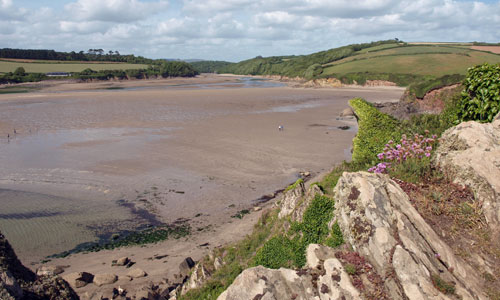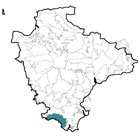This landscape comprises an open, elevated and exposed farmed plateau which has a strong coastal influence and is deeply incised by the scenic estuaries of the Yealm, Erne and Avon. These river systems flow north-south and divide the landscape into three, while the tributary valleys often fan out east-west and are closely juxtaposed with the plateau farmland. In the east the landscape becomes lower-lying, forming more gentle coastal slopes where the geology changes from slates to softer Meadfoot Beds. Where the plateau meets the sea there are high dramatic cliffs as well as coastal slopes and combes that penetrate inland. These combes and the coastal coves and bays are often difficult to access and have an isolated and secretive quality. Views out to sea and along the coast are contained within Bigbury Bay, framed by the headlands of Stoke Point and Bolt Tail. Overall this area is sparsely settled although church spires in the nucleated villages that rest on the upper slopes of valleys or on the plateau are notable vertical features and landmarks.
-
Context
This area comprises a coastal plateau and coastal slopes which extend from the River Yealm Estuary around Bigbury Bay as far as Bolt Tail. It is bounded to the west by the Erne estuary and Plymouth Sound Eastern Plateau and to the east by the Salcombe to Kingsbridge Estuary. To the south is the sea and to the north the landscape undergoes a gradual transition to an area of lower-lying topography with diminishing coastal influences.
-
Constituent Landscape Character Types
Constituent LCTs: 1B: Open Coastal Plateau, 3G: River Valley Slopes and Combes, 4D: Coastal Slopes and Combes, 4H: Cliffs, 4A: Estuaries, 5A: Inland Elevated Undulating Land Part of NCA: 151: South Devon -
Distinctive Characteristics
- High, relatively flat coastal plateau underlain by slates with some sandstones and shales in the north-west; softer Meadfoot slates giving rise to gentler coastal slopes between Thurlestone and Bolt Tail.
- Landscape dissected by estuaries of Yealm, Erne and Avon, which are steeply incised, and by smaller streams in coastal combes.
- Sparsely wooded plateau; wind-blown sculptured hedgerow trees.
- Dense ancient oak woods on Yealm and Erne valley sides, with some conifer plantations.
- Medium to large field sizes on the plateau tops with smaller curving fields of medieval origin on valley slopes defined by Devon hedgebanks.
- Mixed farming with pasture on the steeper estuary slopes.
- Extensive areas of coastal saltmarsh and mudflat habitats; as well as coastal grassland and heath; and scrub on cliffs; and ancient woodland on the steep slopes flanking the estuaries.
- Bronze Age barrows on the plateau, Iron Age hillforts along the coast and estuaries, and an extensive area of historic parkland and estate at Flete on the Erne Estuary.
- Clustered hamlets and villages at road crossings on the plateau and within the coastal combes associated with fishing and/or tourism; often centred on a square-towered church.
- Farmsteads scattered throughout, nestled in dips.
- Some development associated with recreation and tourism including golf courses and caravan sites.
- Strong local vernacular with common use of slate in roofs as well as wall hanging, with some cob/ render cottages, often thatched.
- Sense of isolation, tranquillity and remoteness, enhanced by natural qualities of the estuaries and valley woodlands and the limited road network.
- Views out to sea and to the distinctive island – Burgh Island.
Evaluation
-
Special Qualities and Features:
- Distinctive, unspoilt, and very exposed skylines with views out to sea and inland to Dartmoor.
- High scenic quality reflected in designation as part of the South Devon AONB and Heritage Coast.
- Unusual coastal features including cliffs, headlands, hidden coves, offshore rocks, caves and wave-cut platform, a number of which are RIGSs.
- Valued coastal habitats including saltmarsh, mudflats, grassland and scrub including part of the Erne and Yealm Estuary SSSIs and Plymouth Sound and Estuaries SAC, Blackstone Point SAC (designated for Shore Dock) as well as many CWSs.
- Mixed farming along coast of particular value as habitat for cirl bunting.
- Several Bronze Age barrows and Iron Age hillforts are SMs and the Registered Park and Garden at Flete is listed Grade II.
- Picturesque villages many of which have Conservation Areas with traditional buildings linked by narrow winding lanes.
- Area valued for recreation and tourism and includes South West Coastal Path.
- Much of coastal land owned by National Trust (including Yealm estuary to Stoke Point and Scobbiscombe-Ringmore area).
- High degree of tranquillity and dark night skies that reinforces sense of remoteness.
Forces for Change and Their Landscape Implications:
-
Past and Current
- Past planting of coniferous shelterbelts and plantations, forming conspicuous features on valley sides.
- Decline in woodland management including coppicing, and a spread of invasive species affecting the appearance and biodiversity of the landscape’s woodlands.
- Potential loss of or change in oak-dominated valley woodlands due to spread of Phytophthora, intolerance of water level extremes and more frequent storm events.
- Past intensification of agriculture, resulting in loss of unimproved grassland to arable use or improvement; and loss of habitats and landscape features such as unimproved grassland, coastal heath, hedgebanks, hedgerows, arable weed communities and farmland birds.
- Division of farms, and amalgamation into larger holdings to increase viability, changing the traditional appearance of the landscape, e.g. through the construction of large agricultural buildings.
- Prominent telecommunications mast on plateau.
•Superfluous and poorly-sited road signs and other incremental change affecting landscape quality. - Farm diversification (e.g. quad biking, equine business, campsites) adding to new landscape elements.
- Tourism-related development of the coastline around Bigbury-on-Sea and Thurlestone including golf course, car parks and caravan sites.
- Recreation pressures including growing traffic levels on rural roads (particularly at holiday time) and erosion on South West Coast Path.
- Heavy farm traffic leading to vehicular damage to roadside hedges and woodland.
- Peace and tranquillity interrupted by A379 in the north of the area.
-
Future
- Uncertainty over future of agricultural grants and subsidies, potentially affecting: farm viability and the management of characteristic landscape features such as hedgerows and woodlands; habitat management and coastal grassland restoration schemes; and the continuation of mixed farming.
- Changes in crops and land use as a consequence of change in climate and markets e.g. new markets for bio-energy crops.
- Increased demand for wind turbines and communications masts on higher ground as well as for domestic and community-scale solar panels, with cumulative impacts on landscape.
- Continued demand for tourism-related development, and population growth, resulting in further development of the area and incremental loss of its traditional character.
- Higher sea level and storm frequency as a result of climate change leading to increased coastal erosion.
Strategy
-
Overall Strategy:
To protect the landscape’s high scenic quality and strong sense of place within the South Devon AONB. Enjoyment of the area is encouraged, but tourism-related development is sensitively integrated into the landscape and interpretation of the area’s valuable coastal geological features is encouraged. Sustainable agriculture is supported, and historic landscape features such as field patterns, sunken lanes and archaeological sites are protected and well-managed. Wildlife-friendly mixed farming systems provide for cirl bunting and arable weeds are supported. Important semi-natural habitats such as woodland, maritime grassland and remnant coastal heath are well-managed and strengthened to resist climate change.
Guidelines:
-
Protect
- Protect the high scenic quality of the area within the South Devon AONB.
- Protect settlement forms, resisting further spread or coalescence of settlements.
- Protect traditional building styles and materials, ensuring that any new development is sympathetic in form and style, whilst incorporating sustainable design.
- Protect rural lanes, resisting inappropriate signage and unsympathetic highways works.
- Protect historic features and landmarks such as church towers and hillforts, to ensure they remain integral parts of the landscape.
- Protect tranquillity and dark night skies.
-
Manage
- Manage visitor pressure at sensitive sites to minimise erosion of headlands and paths.
- Manage archaeological sites, controlling visitor pressures and providing sensitive interpretation where appropriate.
- Manage, sustain and support agricultural use, encouraging farmers to graze ‘marginal’ land such as unimproved grassland and coastal heath at appropriate levels and to provide habitat for cirl bunting.
- Manage hedgerows and replace lost or over-mature hedgerow trees and wind-sculpted hedgerow trees.
- Manage and re-link woodlands, encouraging the use of traditional techniques such as coppicing, and retaining the diversity of woodland types within the area.
- Manage areas of plantation to enhance biodiversity.
- Manage, restore and re-link semi-natural coastal habitats (including maritime grassland and coastal heathland) to maximise biodiversity value and improve climate change resilience; and create buffer zones between cliff communities and improved agricultural land where possible.
-
Plan
- Plan to explore sustainable travel options to reduce road traffic during busy holiday periods
- Plan to create green infrastructure links to and from coastal resorts and the South West Coast Path to facilitate recreational opportunities, reduce car usage and enhance the natural settings of development.
- Plan to encourage the reversion of plantations back to broadleaved woodland or grassland habitats on maturity and felling.
- Plan for the future effects of climate change along the coast, allowing natural processes to take place as much as possible, whilst ensuring local people are involved in decision-making relating to future landscapes.

